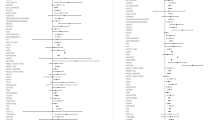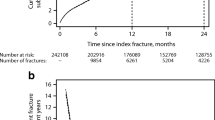Abstract
Purpose of the Review
This review aims to highlight important clinical findings from the over 25 year-long Dubbo Osteoporosis Epidemiology Study particularly focusing on outcomes post fracture.
Recent Findings
Every low trauma fracture in the elderly is associated with an increased risk of a subsequent fracture, with a higher risk in men than women. All major or proximal fractures and even minor fractures in the very elderly or minor fractures that are then followed by re-fracture are associated with premature mortality, greatest in the first 5 years post fracture. Having a subsequent fracture further increases this high mortality risk, but if an individual survives the high risk period, their risk returns to that of the background population. Non-hip non-vertebral fractures account for a significant proportion of the premature mortality. Despite an improvement in overall health and population mortality over the years, excess mortality post fracture has not changed in the last 2 decades.
Summary
All low trauma, fractures in the elderly herald a high risk of poor outcomes, particularly in the first few years post fracture. Early intervention should be initiated.


Similar content being viewed by others
References
Papers of Particular Interest, Published recently, Have Been Highlighted as: • Of importance, •• Of major importance
Simons LA, McCallum J, Simons J, Powell I, Ruys J, Heller R, et al. The Dubbo study: an Australian prospective community study of the health of the elderly. Australian and New Zealand Journal Journal of Medicine. 1990;20:783–9.
Jones G, Nguyen T, Sambrook PN, Kelly PJ, Gilbert C, Eisman JA. Symptomatic fracture incidence in elderly men and women: the Dubbo osteoporosis epidemiology study (DOES). Osteoporos Int. 1994;4:277–82.
•• Bliuc D, Nguyen TV, Eisman JA, Center JR. The impact of nonhip nonvertebral fractures in elderly women and men. J Clin Endocrinol Metab. 2014;99(2):415–23. This paper outlines the burden of non-hip non-vertebral fractures that account for 50% of all fractures, carry a 2-fold risk of subsequent fracture and contribute to 20% of the overall 5-year excess mortality.
Johansson H, Kanis JA, Oden A, Leslie WD, Fujiwara S, Gluer CC, et al. Impact of femoral neck and lumbar spine BMD discordances on FRAX probabilities in women: a meta-analysis of international cohorts. Calcif Tissue Int. 2014;95(5):428–35.
Leslie WD, Lix LM, Johansson H, Oden A, McCloskey E, Kanis JA. Spine-hip discordance and fracture risk assessment: a physician-friendly FRAX enhancement. Osteoporos Int. 2011;22(3):839–47.
Leslie WD, Kovacs CS, Olszynski WP, Towheed T, Kaiser SM, Prior JC, et al. Spine-hip T-score difference predicts major osteoporotic fracture risk independent of FRAX((R)): a population-based report from CAMOS. J Clin Densitom. 2011;14(3):286–93.
Blackburn TD, Howard DB, Leib ES. Utility of spine bone mineral density in fracture prediction within FRAX. J Clin Densitom. 2013;16(1):81–6.
• Alarkawi D, Bliuc D, Nguyen TV, Eisman JA, Center JR. Contribution of lumbar spine BMD to fracture risk in individuals with T-score discordance. J Bone Miner Res. 2016;31(2):274–80. Demonstrates that a low LS bone density in those with higher FN bone density has an independent effect on fracture risk, particularly manifest in those >70 years.
Center JR, Bliuc D, Nguyen TV, Eisman JA. Risk of subsequent fracture after low-trauma fracture in men and women. JAMA. 2007;297(4):387–94.
van Geel TA, van Helden S, Geusens PP, Winkens B, Dinant GJ. Clinical subsequent fractures cluster in time after first fractures. Ann Rheum Dis. 2009;68(1):99–102.
Gehlbach S, Saag KG, Adachi JD, Hooven FH, Flahive J, Boonen S, et al. Previous fractures at multiple sites increase the risk for subsequent fractures: the global longitudinal study of osteoporosis in women. J Bone Miner Res. 2012;27(3):645–53.
Huntjens KM, Kosar S, van Geel TA, Geusens PP, Willems P, Kessels A, et al. Risk of subsequent fracture and mortality within 5 years after a non-vertebral fracture. Osteoporos Int. 2010;21:2075–82.
Johnell O, Kanis JA, Oden A, Sernbo I, Redlund-Johnell I, Petterson C, et al. Fracture risk following an osteoporotic fracture. Osteoporos Int. 2004;15(3):175–9.
Giangregorio LM, Leslie WD. Time since prior fracture is a risk modifier for 10-year osteoporotic fractures. J Bone Miner Res. 2010;25(6):1400–5.
Center JR, Nguyen TV, Schneider P, Sambrook PN, Eisman JA. Mortality after all major types of osteoporotic fracture in men and women: an observational study. Lancet. 1999;353:878–82.
Bliuc D, Nguyen ND, Milch VE, Nguyen TV, Eisman JA, Center JR. Mortality risk associated with low-trauma osteoporotic fracture and subsequent fracture in men and women. JAMA. 2009;301(5):513–21.
•• Bliuc D, Nguyen ND, Nguyen TV, Eisman JA, Center JR. Compound risk of high mortality following osteoporotic fracture and refracture in elderly women and men. J Bone Miner Res. 2013;28(11):2317–24. This paper demonstrates the additional effect of a subsequent fracture on the fracture-associated mortality. Although the greatest mortality risk lies in the first 5 years post initial fracture, this is extended up to 10 years if a re-fracture occurs.
Nguyen ND, Eisman JA, Center JR, Nguyen TV. Risk factors for fracture in nonosteoporotic men and women. J Clin Endocrinol Metab. 2007;92(3):955–62.
Pasco JA, Seeman E, Henry MJ, Merriman EN, Nicholson GC, Kotowicz MA. The population burden of fractures originates in women with osteopenia, not osteoporosis. Osteoporos Int. 2006;17(9):1404–9.
Browner WS, Seeley DG, Vogt TM, Cummings SR. Non-trauma mortality in elderly women with low bone mineral density. Lancet. 1991;338:355–8.
Qu X, Huang X, Jin F, Wang H, Hao Y, Tang T, et al. Bone mineral density and all-cause, cardiovascular and stroke mortality: a meta-analysis of prospective cohort studies. Int J Cardiol. 2013;166(2):385–93.
Johansson H, Oden A, Kanis J, McCloskey E, Lorentzon M, Ljunggren O, et al. Low bone mineral density is associated with increased mortality in elderly men: MrOS Sweden. Osteoporos Int. 2011;22(5):1411–8.
Bliuc D, Alarkawi D, Nguyen TV, Eisman JA, Center JR. Risk of subsequent fractures and mortality in elderly women and men with fragility fractures with and without osteoporotic bone density: the Dubbo osteoporosis epidemiology study. J Bone Miner Res. 2015;30(4):637–46.
Cooper C, Cole ZA, Holroyd CR, Earl SC, Harvey NC, Dennison EM, et al. Secular trends in the incidence of hip and other osteoporotic fractures. Osteoporos Int. 2011;22(5):1277–88.
Adams AL, Shi J, Takayanagi M, Dell RM, Funahashi TT, Jacobsen SJ. Ten-year hip fracture incidence rate trends in a large California population, 1997–2006. Osteoporos Int. 2013;24(1):373–6.
Lau EM, Cooper C, Fung H, Lam D, Tsang KK. Hip fracture in Hong Kong over the last decade—a comparison with the UK. J Public Health Med. 1999;21(3):249–50.
Hagino H, Furukawa K, Fujiwara S, Okano T, Katagiri H, Yamamoto K, et al. Recent trends in the incidence and lifetime risk of hip fracture in Tottori. Japan Osteoporos Int. 2009;20(4):543–8.
Bliuc D, Tran T, Alarkawi D, Nguyen TV, Eisman JA, Center JR. Secular changes in Postfracture outcomes over 2 decades in Australia: a time-trend comparison of excess Postfracture mortality in two birth controls over two decades. J Clin Endocrinol Metab. 2016;101(6):2475–83.
Lyles KW, Colon-Emeric CS, Magaziner JS, Adachi JD, Pieper CF, Mautalen C, et al. Zoledronic acid and clinical fractures and mortality after hip fracture. N Engl J Med. 2007;357(18):1799–809.
Beaupre LA, Morrish DW, Hanley DA, Maksymowych WP, Bell NR, Juby AG, et al. Oral bisphosphonates are associated with reduced mortality after hip fracture. Osteoporos Int. 2010. PubMed Epub 2010/11/06. Eng.
Sambrook PN, Cameron ID, Chen JS, March LM, Simpson JM, Cumming RG, et al. Oral bisphosphonates are associated with reduced mortality in frail older people: a prospective five-year study. Osteoporos Int. 2011;22(9):2551–6.
Nurmi-Luthje I, Sund R, Juntunen M, Luthje P. Post-hip fracture use of prescribed calcium plus vitamin D or vitamin D supplements and antiosteoporotic drugs is associated with lower mortality: a nationwide study in Finland. J Bone Miner Res. 2011;26(8):1845–53.
Bondo L, Eiken P, Abrahamsen B. Analysis of the association between bisphosphonate treatment survival in Danish hip fracture patients—a nationwide register-based open cohort study. Osteoporos Int. 2013;24(1):245–52.
• Brozek W, Reichardt B, Zwerina J, Dimai HP, Klaushofer K, Zwettler E. Antiresorptive therapy and risk of mortality and refracture in osteoporosis-related hip fracture: a nationwide study. Osteoporos Int. 2016;27(1):387–96. Large database study demonstrating a beneficial effect of bisphosphonate therapy on survival following a hip fracture.
Center JR, Bliuc D, Nguyen ND, Nguyen TV, Eisman JA. Osteoporosis medication and reduced mortality risk in elderly women and men. J Clin Endocrinol Metab. 2011;96(4):1006–14.
Corrado A, Santoro N, Cantatore FP. Extra-skeletal effects of bisphosphonates. Joint, bone, spine : revue du rhumatisme. 2007;74(1):32–8.
Gulson B, Mizon K, Smith H, Eisman J, Palmer J, Korsch M, et al. Skeletal lead release during bone resorption: effect of bisphosphonate treatment in a pilot study. Environ Health Perspect. 2002;110(10):1017–23.
Guise TA. Antitumor effects of bisphosphonates: promising preclinical evidence. Cancer Treat Rev. 2008;34(Suppl 1):S19–24.
Waning DL, Guise TA. Cancer-associated muscle weakness: What’s bone got to do with it? BoneKEy reports. 2015;4:691.
Junankar S, Shay G, Jurczyluk J, Ali N, Down J, Pocock N, et al. Real-time intravital imaging establishes tumor-associated macrophages as the extraskeletal target of bisphosphonate action in cancer. Cancer discovery. 2015;5(1):35–42.
Author information
Authors and Affiliations
Corresponding author
Ethics declarations
Conflict of Interest
Jacqueline Center reports grants from National Health and Medical Research Council, other from Ernst Heine Foundation, Osteoporosis-Amgen grant, grants from BUPA Health Foundation, untied grants from Amgen, Merck Sharpe and Dohme, Novartis, Sanofi Aventis, and Servier during the conduct of the study; personal fees from Amgen, non-financial support from Merck Sharp and Dohme, personal fees from Allergan Australia, outside the submitted work.
Human and Animal Rights and Informed Consent
This article does not contain any studies with human or animal subjects performed by any of the authors.
Additional information
This article is part of the Topical Collection on Skeletal Biology and Regulation
Rights and permissions
About this article
Cite this article
Center, J.R. Fracture Burden: What Two and a Half Decades of Dubbo Osteoporosis Epidemiology Study Data Reveal About Clinical Outcomes of Osteoporosis. Curr Osteoporos Rep 15, 88–95 (2017). https://doi.org/10.1007/s11914-017-0352-5
Published:
Issue Date:
DOI: https://doi.org/10.1007/s11914-017-0352-5




